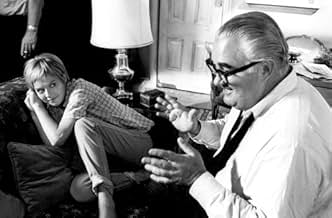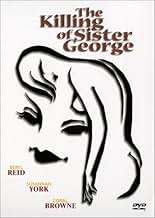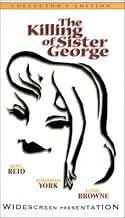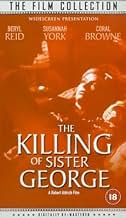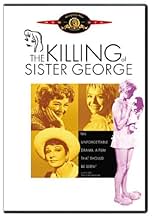IMDb RATING
7.0/10
2.7K
YOUR RATING
The life of a soap opera actress begins to unravel as she fears her character will be written out of the series.The life of a soap opera actress begins to unravel as she fears her character will be written out of the series.The life of a soap opera actress begins to unravel as she fears her character will be written out of the series.
- Awards
- 1 nomination total
- Director
- Writers
- All cast & crew
- Production, box office & more at IMDbPro
Featured reviews
Am I the only one who finds it painfully touching that Robert Aldrich went from the biggest hit of his career--the almost woman-free DIRTY DOZEN--to the kind of movie he really wanted to make, i.e., a stagebound melodrama about an aging lesbian soap star's love for a demented nymphet? In its day, SISTER GEORGE was considered the ne plus ultra in coarse homophobia; critics saw the sweaty thumbprints of the Aldrich Touch on every girl-on-girl scene. (Does anyone now lambaste THE BITTER TEARS OF PETRA VON KANT for not being hardhitting docudrama?) In retrospect, the movie seems to me one of Aldrich's most affecting, with Coral Browne (December) and a teeny, teenaged Susannah York (May) grand-slamming this folie a deux to a fare-thee-well.
Robert Aldrich is a director who rarely gets the attention he deserves. Ridiculously versatile he made the fascinating Film Noir 'Kiss Me Deadly', the gothic black comedy 'Whatever Happened To Baby Jane?', and the macho "tough guys on a mission" action classic 'The Dirty Dozen' to name just three in a long career. Just to emphasize that he could do just about anything, one of the first movies he made after 'The Dirty Dozen' was 'The Killing Of Sister George'. It's hard to imagine two more different movies! George is a very English picture about a much loved soap opera star (played by Beryl Reid) who has to juggle a career crisis with a complex lesbian relationship (her lover being played by Susanna York). Reid was well known to British audiences through her TV work, especially a couple of highly popular John Le Carre adaptations. Reid originated the Sister George role on the stage and she really makes the most of it in this movie. Her performance is terrific, hilariously bitchy and also very sad and pathetic. York is also good, and the lesbian subject matter must have been very shocking for the time. It may look a little dated now, but in context it is quite sensitively handled. There are some great actors in the supporting cast, most notably Coral Browne ('Theatre Of Blood') who plays a TV producer who has her eye on York. 'The Killing Of Sister George' deserves a bigger audience. I highly recommend it and hope that anyone who enjoys it looks further into the career of the Robert Aldrich, a seriously underrated film maker!
Seeing Beryl Reid mouth silently a four-letter swear word when such things didn't happen in films and drunkenly canoodling with two young nuns in the back of a London cab is both quite outstanding and rather lovable.
Miss Reid, who I only got to see in my childhood as a twee, granny-like innocent (the sort that she plays for real in a TV serial as Sister George, a homely district nurse), I found The Killing Of... both delicious and ever astounding in its frankness and of her rather warped relationship with the much younger Susannah York.
Warped, not because of the age difference, nor of their same-sex partnership, but because June Buckridge (Reid) has a cruel streak that is borne out by her playing sadistic mind games with Alice "Childie" (York).
Sister George, in the best tradition of TV soaps, is being killed off, to make way for an Australian replacement. Hence June's venomous outpourings and increasingly erratic behaviour.
Equally interesting is the London of the late '60s, both in its landmarks but also its people and fashions, whether that's in how they live and/or how they dress and present themselves.
Though real soaps cover such material freely and openly these days, 42 years ago, it must have been a very different kettle of fish. Lesbianism back in those days was not only considered immoral but also a mental aberration and had to be so hidden, in an attempt to prove to those 'righteous' souls that it did not exist. Therefore, it must have been a very brave undertaking as a film, though it originated as a play, written by Frank Marcus.
Having now seen it again, I consider Robert Aldrich's ground-breaking film to be a bit of a classic and one, which, no doubt I'll want to see again in a few years time. It really is a piece of British cinematic history.
Miss Reid, who I only got to see in my childhood as a twee, granny-like innocent (the sort that she plays for real in a TV serial as Sister George, a homely district nurse), I found The Killing Of... both delicious and ever astounding in its frankness and of her rather warped relationship with the much younger Susannah York.
Warped, not because of the age difference, nor of their same-sex partnership, but because June Buckridge (Reid) has a cruel streak that is borne out by her playing sadistic mind games with Alice "Childie" (York).
Sister George, in the best tradition of TV soaps, is being killed off, to make way for an Australian replacement. Hence June's venomous outpourings and increasingly erratic behaviour.
Equally interesting is the London of the late '60s, both in its landmarks but also its people and fashions, whether that's in how they live and/or how they dress and present themselves.
Though real soaps cover such material freely and openly these days, 42 years ago, it must have been a very different kettle of fish. Lesbianism back in those days was not only considered immoral but also a mental aberration and had to be so hidden, in an attempt to prove to those 'righteous' souls that it did not exist. Therefore, it must have been a very brave undertaking as a film, though it originated as a play, written by Frank Marcus.
Having now seen it again, I consider Robert Aldrich's ground-breaking film to be a bit of a classic and one, which, no doubt I'll want to see again in a few years time. It really is a piece of British cinematic history.
While there is delicate humor here, as in the movie's satire on the twee reassurances and stereotyping of an English soap opera's portrayal of homely English village life, this movie is in the end an unsettling portrait of the human condition, of the ugliness, the uncontrollable and incendiary nature of our sexual and emotional longings and need.
I spent years wanting to see this movie, if only because of its legendary nature and Coral Browne's presence in the cast, and it's nothing like what I imagined. Given the title and all the talk in books about scenes set in a dark and intense demimondaine world of lesbian bars, I pictured some sort of police procedural about lesbians being killed by a serial killer, a Sidney Sheldon-type story.
Ostensibly a portrait of an aging actress's dying career, the heart of the picture is the competition among the characters for love, for the ruthless quest for success and the money and companionship that go with it.
There is constant sado-masochistic emotional gamesmanship here, with characters playing roles that are alternately passive and active. One character pretends to be not much more than a slip of a girl and sits by and watches as others compete for her attentions.
The sex scene in the movie, while ugly in the extreme, is vital to the film's message. (I'm amazed that this aired, even late at night, on Turner Classic Movies, so that I, thankfully, got a chance to see the movie.) Coral Browne's face, stripped of its mask of demure self-possession, exposing the animal (the monster?) that we all are at the core of our being--that's something to see. And unsettling.
I'll never particularly care for Susannah York. She'll always strike me as a bit of an over-praised, over-successful relic of the 1960s, a kind of prissy relic, but what a film, even with some longeurs. And the towering--both literally and figuratively--Coral Browne: what a presence.
I spent years wanting to see this movie, if only because of its legendary nature and Coral Browne's presence in the cast, and it's nothing like what I imagined. Given the title and all the talk in books about scenes set in a dark and intense demimondaine world of lesbian bars, I pictured some sort of police procedural about lesbians being killed by a serial killer, a Sidney Sheldon-type story.
Ostensibly a portrait of an aging actress's dying career, the heart of the picture is the competition among the characters for love, for the ruthless quest for success and the money and companionship that go with it.
There is constant sado-masochistic emotional gamesmanship here, with characters playing roles that are alternately passive and active. One character pretends to be not much more than a slip of a girl and sits by and watches as others compete for her attentions.
The sex scene in the movie, while ugly in the extreme, is vital to the film's message. (I'm amazed that this aired, even late at night, on Turner Classic Movies, so that I, thankfully, got a chance to see the movie.) Coral Browne's face, stripped of its mask of demure self-possession, exposing the animal (the monster?) that we all are at the core of our being--that's something to see. And unsettling.
I'll never particularly care for Susannah York. She'll always strike me as a bit of an over-praised, over-successful relic of the 1960s, a kind of prissy relic, but what a film, even with some longeurs. And the towering--both literally and figuratively--Coral Browne: what a presence.
Beryl Reid gives a no-holds-barred performance as an aging lesbian actress who's already teetering on the edge when she gets word that her character in a TV soap opera is to be killed off. She takes out her frustrations on her childlike lover (Susannah York) and a production head (Coral Browne), the two of whom eventually become intimate on their own. The script-reading sequence had me howling with laughter, and Reid's non-stop barrage of put-downs, insults, wisecracks and other hateful remarks are acidly hilarious. A surprisingly realistic sex scene near the end is pretty graphic for its time (I almost felt like looking away) and we never learn much about Browne's icy character, but the concluding scene is gut-wrenching, as is the final line of dialogue. *** from ****
Did you know
- TriviaThe lesbian lovemaking scene so disgusted Robert Aldrich's longtime composer friend Frank De Vol that he quit the production and didn't work with Aldrich for several years.
- GoofsWhen George asks for a pint of beer the waiter arrives with it on a tray and it is half full with half a glass of head but when he puts it on the table it's much fuller, with only about an inch of head on it.
- Crazy creditsDuring the opening credits, the picture distractingly flips from left to right as the main character travels through claustrophobia-inducing alleyways.
- ConnectionsFeatured in Before Stonewall (1984)
- How long is The Killing of Sister George?Powered by Alexa
Details
- Release date
- Country of origin
- Language
- Also known as
- Le prix de la gloire
- Filming locations
- Production companies
- See more company credits at IMDbPro
- Runtime2 hours 18 minutes
- Sound mix
- Aspect ratio
- 1.85 : 1
Contribute to this page
Suggest an edit or add missing content

Top Gap
By what name was Faut-il tuer Sister George? (1968) officially released in India in English?
Answer

